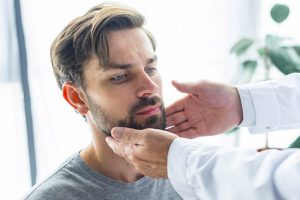Temporomandibular joint disorder (TMJ), also known as temporomandibular disorder (TMD), is a prevalent condition that affects millions of people worldwide. The temporomandibular joint (TMJ) is the joint that connects your jawbone to your skull, allowing you to talk, chew, and yawn. When problems arise with this joint and the surrounding muscles, it can lead to discomfort and pain known as TMJ or TMD.
In this article, we will delve into the causes, symptoms, and treatment options for TMJ/TMD, providing valuable insights to help you understand this condition better.
Causes of TMJ/TMD:
The exact cause of TMJ/TMD is often challenging to determine due to its multifactorial nature. However, several factors can contribute to its development:
- Jaw Injuries: Trauma to the jaw, such as from a sports-related injury or accident, can lead to TMJ problems.
- Teeth Clenching and Grinding: Habitual clenching or grinding of teeth, known as bruxism, can strain the TMJ and surrounding muscles.
- Misalignment of the Jaw: Malocclusion, where the upper and lower teeth do not fit together correctly, can put stress on the TMJ.
- Arthritis: Various forms of arthritis, such as osteoarthritis and rheumatoid arthritis, can affect the TMJ.
- Stress and Anxiety: Emotional stress and anxiety may cause individuals to clench their jaws, putting additional pressure on the TMJ.
- Connective Tissue Disorders: Certain connective tissue disorders, like Ehlers-Danlos syndrome, can increase the risk of TMJ/TMD.

Symptoms of TMJ/TMD:
TMJ/TMD can manifest with a wide range of symptoms, which may vary from person to person. Some common signs and symptoms include:
- Jaw Pain: Pain or tenderness in the jaw joint area, especially when chewing or opening your mouth wide.
- Facial Pain: Pain in the face, particularly around the cheeks, temples, or ears.
- Difficulty Opening or Closing the Mouth: A sensation of jaw stiffness or limited jaw movement.
- Clicking or Popping Sounds: Clicking, popping, or grating noises when opening or closing the mouth.
- Earache and Ringing in the Ears: Pain or ringing sensations in the ears that may be mistaken for an ear infection.
- Headaches: Recurring headaches, especially in the temples or forehead.
- Neck and Shoulder Pain: Pain or tension in the neck and shoulders, often associated with jaw discomfort.
- Facial Swelling: Swelling on one or both sides of the face.

Treatment Options for TMJ/TMD:
Fortunately, various treatment options are available to manage TMJ/TMD effectively. The appropriate course of action depends on the severity of the condition and its underlying causes. Some common treatment approaches include:
- Lifestyle Modifications: Making changes such as eating soft foods, avoiding extreme jaw movements, and practicing stress-reducing techniques can alleviate symptoms.
- Pain Management: Over-the-counter pain relievers, such as ibuprofen, can help reduce pain and inflammation.
- Massage Therapy: A massage therapist can physically isolate specific muscle groups of the face, neck, and shoulders to alleviate chronic spasms and associated pain.
- Physical Therapy: A physical therapist can guide you through exercises to strengthen the jaw muscles and improve joint function.
- Oral Appliances: Dentists may recommend custom-made oral splints or mouthguards to reposition the jaw and prevent teeth clenching and grinding.
- Injections: In some cases, Anesthetics and Botox injections can be used to immediately relieve pain and muscle spasms, which relax the jaw muscles and provide relief from TMJ pain.
- IV Infusion Therapy: Many headaches are the result of dehydration, so rehydrating the body through IV Infusion can provide immediate relief. Supplementing the IV with additional fluids and ancillary medications have proven to be extremely effective in nearly immediate pain relief.
- Iontophoresis: Also referred to as “electromotive drug administration” (EMDA), iontophoresis delivers a medicine or other chemical through the skin. In a manner of speaking, it is an injection without a needle, and may be described as non-invasive.
- Dental Treatments: Correcting dental issues, such as misalignment of teeth and/or replacing missing teeth, may improve TMJ symptoms.
- Arthroscopic Surgery: In severe cases where other treatments have not been successful, surgical intervention, such as arthrocentesis or arthroscopyt, may be considered.
